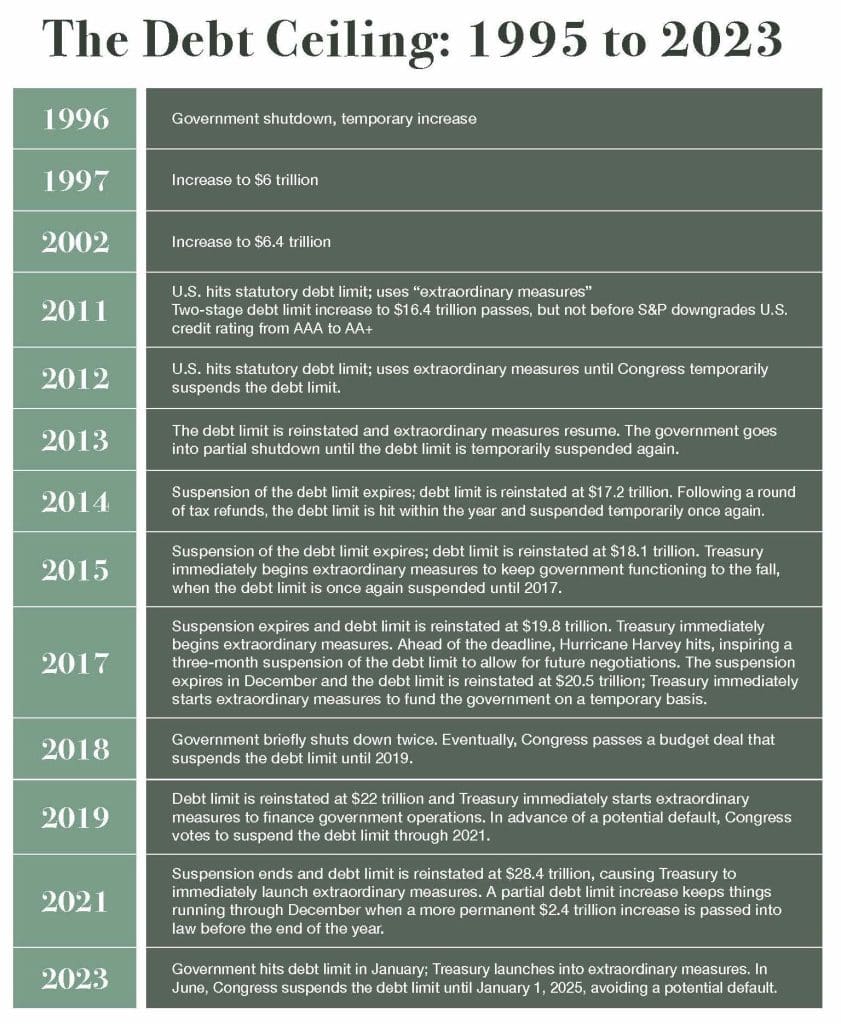Politicians on Capitol Hill went to battle over the debt ceiling once again this spring. The cliff notes version is: It looks like we averted the crisis, again, but it’s set to resurface in 18 months (January 1, 2025).
While the whole situation can be confusing, the debt ceiling being lifted probably doesn’t come as a shock. By now, we’ve grown accustomed to the country’s debt ceiling issues being resolved at the eleventh hour. Rather than questioning if the ceiling will be lifted, most investors are concerned about the impact such a crisis has on their portfolios.
Understanding the “why” and “how” behind these debt ceiling negotiations can help you process any market volatility they cause.
There’s a limit to how much money the U.S. Treasury can borrow.
Essentially, the government borrows money to pay for government spending, usually by issuing Treasury bonds. Congress sets this limit. While the debt ceiling is connected to government spending, it’s separate from the Congressional budget passed each year.
If the Treasury can’t borrow more money, the government risks defaulting on its debt.
Because the debt ceiling is always raised or suspended at the last minute, we may forget what’s at stake if the Treasury Department runs out of money: The U.S. government could default on its debt. A default would pose serious risks to both the U.S. and global economies. U.S. Treasuries are widely held by regular Americans (think about your bond portfolio) and foreign governments alike. Both rely on regular interest payments from the U.S. government; for some retirees, these payments form part of their income.
The U.S. has never defaulted on its debt.
Famously, Treasuries are backed by the full faith of the U.S. government, which carries significant weight because the U.S. has never defaulted. It’s one reason Treasuries are considered a “safe” investment, at least when it comes to regular interest payments and the return of principal.
Politicians sometimes use this as a negative tactic.
Because the consequences of a default are so significant, and a failure to raise the debt limit pushes the U.S. toward default, politicians can force their counterparts to the negotiating table. Once there, legislators may be more willing to compromise to avoid economic catastrophe.
There are several ways to avoid default tied to the debt ceiling.
While the debt ceiling is separate from the Congressional budget, they’re closely linked. That’s because to control the national debt, the government can increase revenue, cut spending, or increase the debt limit. All three are controlled by Congress, and since increasing revenue means increasing taxes, most conversation focuses on spending cuts.
Negotiations around the debt ceiling, however, often expand beyond the economy to focus on other divisive issues, including immigration.
In the absence of timely legislation to increase the debt limit—in other words, if politicians reach an impasse—the Treasury Department may engage in “extraordinary measures” to avoid default (and has done so many times in recent years). These measures may vary based on circumstance but can involve suspending special Treasuries issued to government employees, suspending investments or reinvestments, and so on.
If the Treasury Department runs out of extraordinary measures, the government may enter partial shutdown to curb spending and avoid default. In the past, this involved shutting the national parks and furloughing certain federal employees.
Outside of the budget, Congress may be able to avoid default by suspending the debt ceiling rather than increasing it. So far, Congress has only issued temporary suspensions, meaning negotiations over potential increases to the debt limit resume at a specified future date. (This is what happened in June 2023—Congress suspended the debt limit until January 1, 2025.)
Finally, Congress can raise the debt limit. Recently, Congress has raised the debt limit by smaller percentages, leading to more frequent negotiations.
Battles over the debt limit are getting more frequent.
If you’re thinking, “Didn’t we just go through this?” The answer is yes. Congress has increased the debt ceiling 78 times since 1960, and many of the newer increases are for shorter terms. For instance, it was increased temporarily in October 2021, officially in December 2021, and again on June 3, 2023.

Is there anything investors can learn from recent debt ceiling decisions?
Think of U.S. debt like your own personal debt. While the scale and minutiae differ, the principles are relatively the same. In both the Treasury and your own financial life, there are opportunities to take on “good” debt and “bad” debt.
Good debt is purposeful and typically comes with a lower interest rate—your mortgage, auto loan, student loans, or a HELOC are all good examples. Bad debt tends to carry higher-interest rates and/or funds things that don’t add value you to your life overall.
When it comes to government debt, millions of Americans rely on income from Treasury bonds (in other words, U.S. government debt) to help pad their retirement portfolios. Eliminating that debt completely would have detrimental effects on the economy. But as with personal finance, many experts point out that an overleveraged U.S. government could potentially weaken the country. Whether it’s your household budget or the full force of the U.S. Treasury, the decision to add more debt shouldn’t be taken lightly.
If you have any questions about the debt ceiling or your own personal debt, our doors are always open; feel free to reach out anytime.

